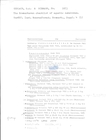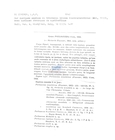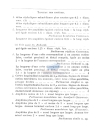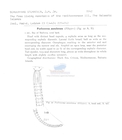Nemys taxon details
Pselionema Cobb, 1933
2389 (urn:lsid:marinespecies.org:taxname:2389)
accepted
Genus
Pselionemoides Haspeslagh, 1972 · unaccepted
- Species Pselionema annulatum (Filipjev, 1922) Cobb, 1933
- Species Pselionema beauforti Chitwood, 1936
- Species Pselionema concinnum Tchesunov & Miljutina, 2002
- Species Pselionema deconincki Vitiello & Haspeslagh, 1972
- Species Pselionema detriticola Vitiello, 1974
- Species Pselionema dissimile Vitiello, 1974
- Species Pselionema huakita Leduc, 2024
- Species Pselionema longissimum Gerlach, 1953
- Species Pselionema minutum Vitiello & Haspeslagh, 1972
- Species Pselionema mirabile Tchesunov & Miljutina, 2002
- Species Pselionema ornatum (Timm, 1961) Hopper, 1973
- Species Pselionema parasimplex Vitiello, 1971
- Species Pselionema psednum Holovachov, Tandingan De Ley, Mundo-Ocampo, Baldwin, Rocha-Olivares & De Ley, 2008
- Species Pselionema richardi De Coninck, 1942
- Species Pselionema simile De Coninck, 1942
- Species Pselionema simplex De Coninck, 1942
- Species Pselionema ceramis Haspeslagh, 1972 (unaccepted > nomen nudum)
- Species Pselionema hexalatum Chitwood, 1936 accepted as Pselionema beauforti Chitwood, 1936
- Species Pselionema leptocephalum Haspeslagh, 1972 (unaccepted > nomen nudum)
- Species Pselionema longiseta Ward, 1974 accepted as Pterygonema longiseta (Ward, 1974) Tchesunov & Miljutina, 2002
- Species Pselionema rigidum Chitwood, 1936 accepted as Pselionema beauforti Chitwood, 1936
- Species Pselionema robustum Haspeslagh, 1972 (unaccepted > nomen nudum)
marine, brackish, fresh, terrestrial
recent only
Not documented
Nemys eds. (2025). Nemys: World Database of Nematodes. Pselionema Cobb, 1933. Accessed at: https://www.nemys.ugent.be/aphia.php?p=taxdetails&id=2389 on 2025-07-01
Date
action
by
2004-12-21 15:54:05Z
created
db_admin
2006-09-28 06:51:36Z
changed
Martinez, Olga
original description
(of Pselionemoides Haspeslagh, 1972) Haspeslagh, G. (1972). Superfamilie Ceramonematoidea De Coninck, 1965: een monografische studie. <em>Deel 1, 2 en 3. Diss., Gent, Deel 1 (pp. I-IV, 1-175), Diss., Gent, Deel 2 (pp. 176-359, 28 tabs.), Diss., Gent, Deel 3 (136pls.).</em> (look up in IMIS) [details] Available for editors  [request]
[request]
basis of record Nemaslan: Biodiversity of Antarctic Nematodes (2004). (look up in IMIS) [details]
additional source Neave, Sheffield Airey. (1939-1996). Nomenclator Zoologicus vol. 1-10 Online. <em>[Online Nomenclator Zoologicus at Checklistbank. Ubio link has gone].</em> , available online at https://www.checklistbank.org/dataset/126539/about [details]
additional source Various Authors (2000). Nematode filing cabinet of the Marine Biology Section Ugent - in combination with the NemasLan Ms-Access database (published on CD-Rom, 2000) (look up in IMIS) [details]
additional source Holovachov, O.; De Ley, P.; Baldwin, J.; Rocha-Olivares, A.; Tandingan De Ley, I.; Mundo-Ocampo, M. (2008). Nematodes from the Gulf of California. Part 1. The genera Ceramonema Cobb, 1920, Pselionema Cobb in Cobb, 1933 and Pterygonema Gerlach, 1954 (Nematoda: Ceramonematidae). <em>Nematology.</em> 10(3): 347-373., available online at https://doi.org/10.1163/156854108783900311 [details] Available for editors [request]
[request]
additional source Dando, P. R.; Austen, M. C.; Burke, Jr. R. A.; Kendall, M. A.; Kennicutt, II M. C.; Judd, A. G.; Moore, D. C.; O'Hara, S. C. M.; Schmaljohann, R.; Southward, A. J. (1991). Ecology of a North Sea pockmark with an active methane seep. <em>Marine Ecology Progress Series.</em> 70: 49-63. [details] Available for editors [request]
[request]
additional source Danovaro, R.; Gambi, M. C.; Dell'Anno, A.; Corinaldesi, C.; Fraschetti, S.; Vanreusel, A.; Vincx, M.; Gooday, A. J. (2008). Exponential decline of deep-sea ecosystem functioning linked to benthic biodiversity loss. <em>Current Biology.</em> 18(1): 1-8 + supplemental data: S1-S6; 1-16. (look up in IMIS), available online at https://doi.org/10.1016/j.cub.2007.11.056 [details] Available for editors [request]
[request]
additional source Gobin, J. F. (2007). Free-living marine nematodes of hard bottom substrates in Trinidad and Tobago, West Indies. <em>Bulletin of Marine Science.</em> 81(1): 73–84. [details]
additional source Miljutin, D. M.; Gad, G.; Miljutina, M. M.; Mokievsky, V. O.; Fonseca-Genevois, V.; Esteves, A. M. (2010). The state of knowledge on deep-sea nematode taxonomy: how many valid species are known down there?. <em>Marine Biodiversity.</em> 40(3): 143-159., available online at https://doi.org/10.1007/s12526-010-0041-4 [details] Available for editors [request]
[request]
additional source Danovaro, R.; Gambi, C.; Lampadariou, N.; Tselepides, A. (2008). Deep-sea nematode biodiversity in the Mediterranean basin: testing for longitudinal, bathymetric and energetic gradients. <em>Ecography.</em> 31(2): 231-244., available online at https://doi.org/10.1111/j.0906-7590.2008.5484.x [details] Available for editors [request]
[request]
additional source Venekey, V.; Fonseca-Genevois, V.; Santos, P. J. P. (2010). Biodiversity of free-living marine nematodes on the coast of Brazil: a review. <em>Zootaxa.</em> 2568: 39–66. [details] Available for editors [request]
[request]
ecology source Raes, M.; Vanreusel, A. (2006). Microhabitat type determines the composition of nematode communities associated with sediment-clogged cold-water coral framework in the Porcupine Seabight (NE Atlantic). <em>Deep-Sea Research Part I.</em> 53 (12): 880-1894. [details] Available for editors [request]
[request]
ecology source Vanreusel, A., M. Vincx, D. Van Gansbeke & W. Gijselinck, W. (1992). Structural analysis of the meiobenthos communities of the shelf break area in two stations of the Gulf of Biscay (N.E. Atlantic). <em>Belgian Journal of Zoology.</em> 122(2):185-202. (look up in IMIS) [details] Available for editors [request]
[request]
basis of record Nemaslan: Biodiversity of Antarctic Nematodes (2004). (look up in IMIS) [details]
additional source Neave, Sheffield Airey. (1939-1996). Nomenclator Zoologicus vol. 1-10 Online. <em>[Online Nomenclator Zoologicus at Checklistbank. Ubio link has gone].</em> , available online at https://www.checklistbank.org/dataset/126539/about [details]
additional source Various Authors (2000). Nematode filing cabinet of the Marine Biology Section Ugent - in combination with the NemasLan Ms-Access database (published on CD-Rom, 2000) (look up in IMIS) [details]
additional source Holovachov, O.; De Ley, P.; Baldwin, J.; Rocha-Olivares, A.; Tandingan De Ley, I.; Mundo-Ocampo, M. (2008). Nematodes from the Gulf of California. Part 1. The genera Ceramonema Cobb, 1920, Pselionema Cobb in Cobb, 1933 and Pterygonema Gerlach, 1954 (Nematoda: Ceramonematidae). <em>Nematology.</em> 10(3): 347-373., available online at https://doi.org/10.1163/156854108783900311 [details] Available for editors
additional source Dando, P. R.; Austen, M. C.; Burke, Jr. R. A.; Kendall, M. A.; Kennicutt, II M. C.; Judd, A. G.; Moore, D. C.; O'Hara, S. C. M.; Schmaljohann, R.; Southward, A. J. (1991). Ecology of a North Sea pockmark with an active methane seep. <em>Marine Ecology Progress Series.</em> 70: 49-63. [details] Available for editors
additional source Danovaro, R.; Gambi, M. C.; Dell'Anno, A.; Corinaldesi, C.; Fraschetti, S.; Vanreusel, A.; Vincx, M.; Gooday, A. J. (2008). Exponential decline of deep-sea ecosystem functioning linked to benthic biodiversity loss. <em>Current Biology.</em> 18(1): 1-8 + supplemental data: S1-S6; 1-16. (look up in IMIS), available online at https://doi.org/10.1016/j.cub.2007.11.056 [details] Available for editors
additional source Gobin, J. F. (2007). Free-living marine nematodes of hard bottom substrates in Trinidad and Tobago, West Indies. <em>Bulletin of Marine Science.</em> 81(1): 73–84. [details]
additional source Miljutin, D. M.; Gad, G.; Miljutina, M. M.; Mokievsky, V. O.; Fonseca-Genevois, V.; Esteves, A. M. (2010). The state of knowledge on deep-sea nematode taxonomy: how many valid species are known down there?. <em>Marine Biodiversity.</em> 40(3): 143-159., available online at https://doi.org/10.1007/s12526-010-0041-4 [details] Available for editors
additional source Danovaro, R.; Gambi, C.; Lampadariou, N.; Tselepides, A. (2008). Deep-sea nematode biodiversity in the Mediterranean basin: testing for longitudinal, bathymetric and energetic gradients. <em>Ecography.</em> 31(2): 231-244., available online at https://doi.org/10.1111/j.0906-7590.2008.5484.x [details] Available for editors
additional source Venekey, V.; Fonseca-Genevois, V.; Santos, P. J. P. (2010). Biodiversity of free-living marine nematodes on the coast of Brazil: a review. <em>Zootaxa.</em> 2568: 39–66. [details] Available for editors
ecology source Raes, M.; Vanreusel, A. (2006). Microhabitat type determines the composition of nematode communities associated with sediment-clogged cold-water coral framework in the Porcupine Seabight (NE Atlantic). <em>Deep-Sea Research Part I.</em> 53 (12): 880-1894. [details] Available for editors
ecology source Vanreusel, A., M. Vincx, D. Van Gansbeke & W. Gijselinck, W. (1992). Structural analysis of the meiobenthos communities of the shelf break area in two stations of the Gulf of Biscay (N.E. Atlantic). <em>Belgian Journal of Zoology.</em> 122(2):185-202. (look up in IMIS) [details] Available for editors
 Present
Present  Inaccurate
Inaccurate  Introduced: alien
Introduced: alien  Containing type locality
Containing type locality




